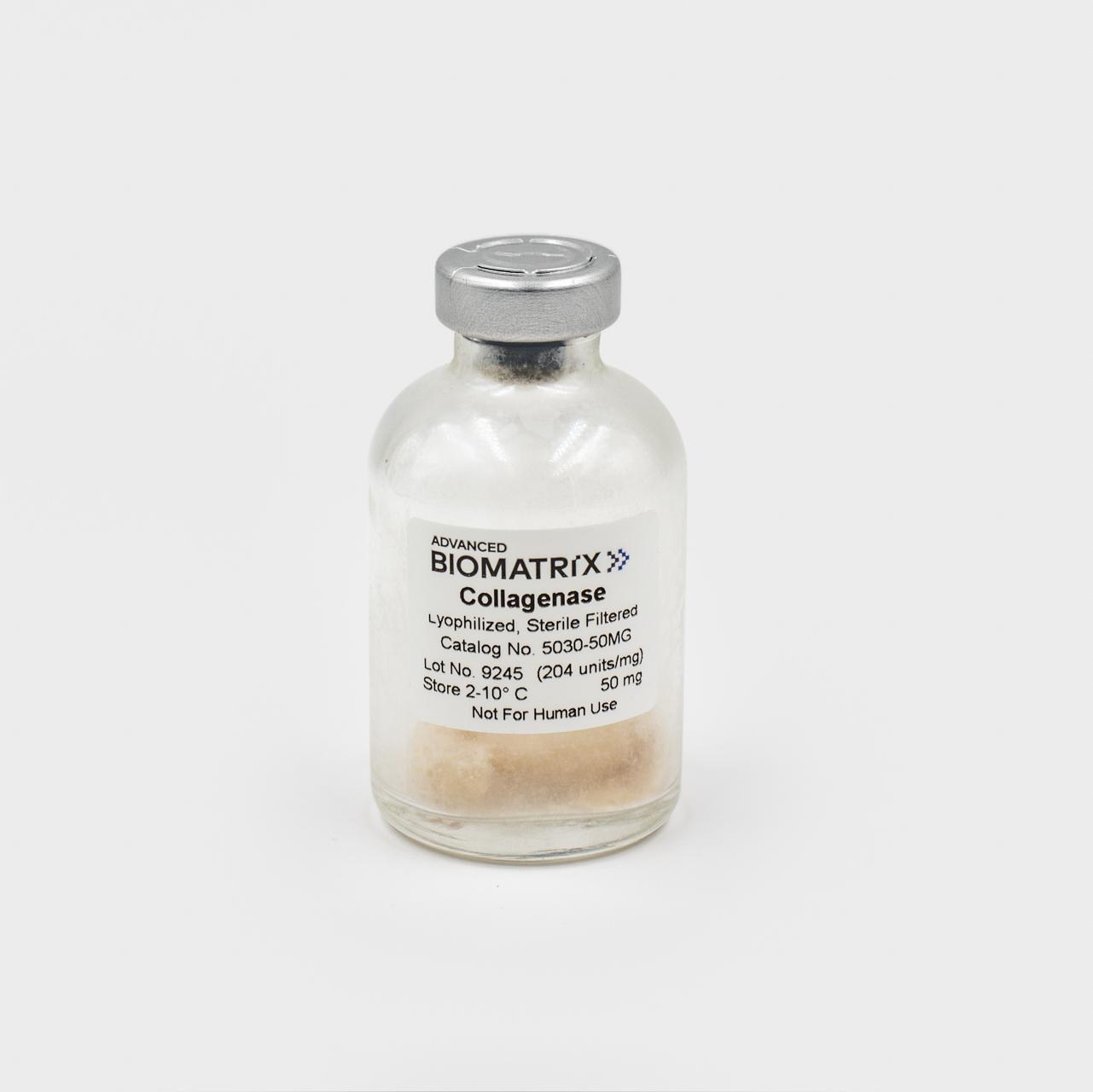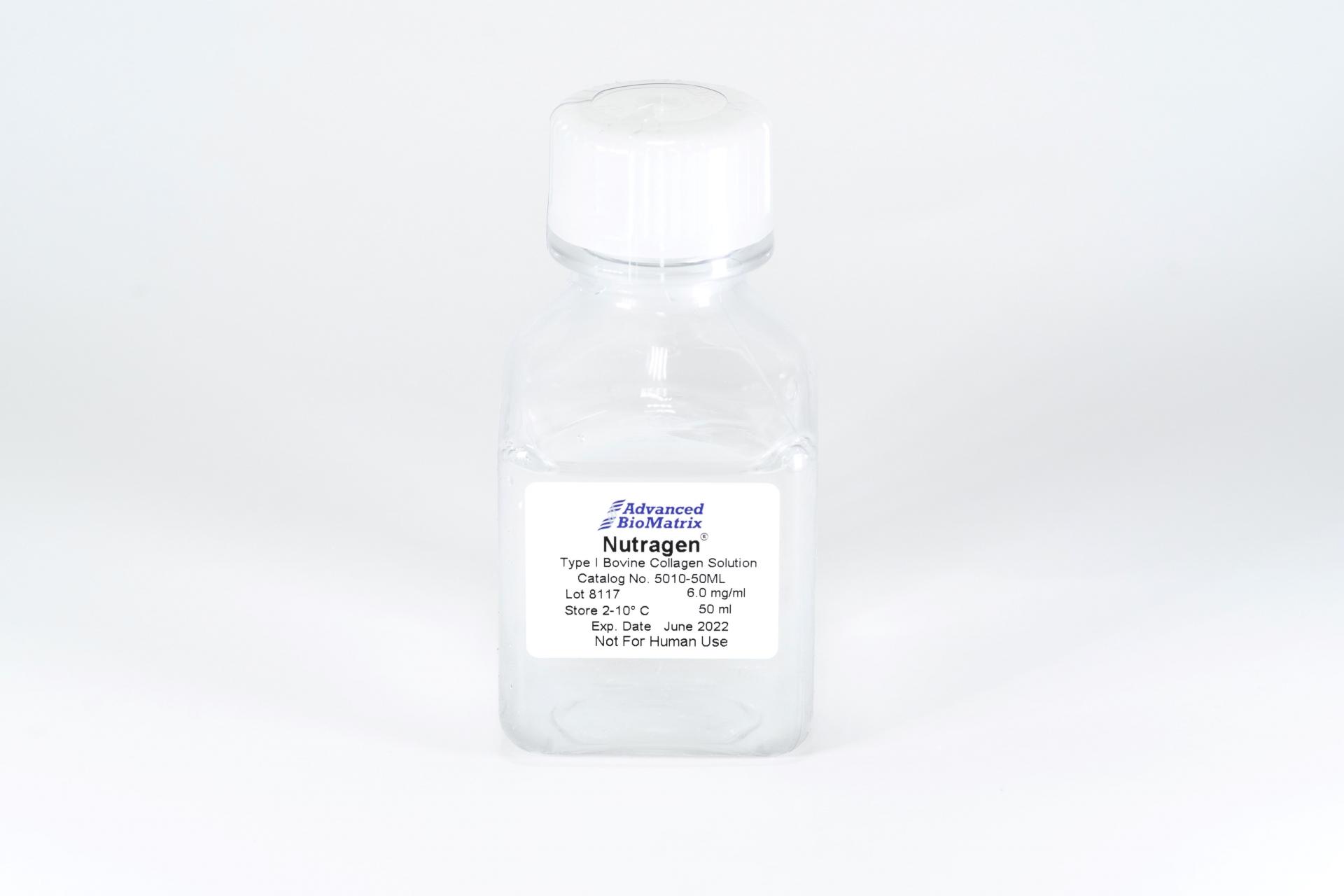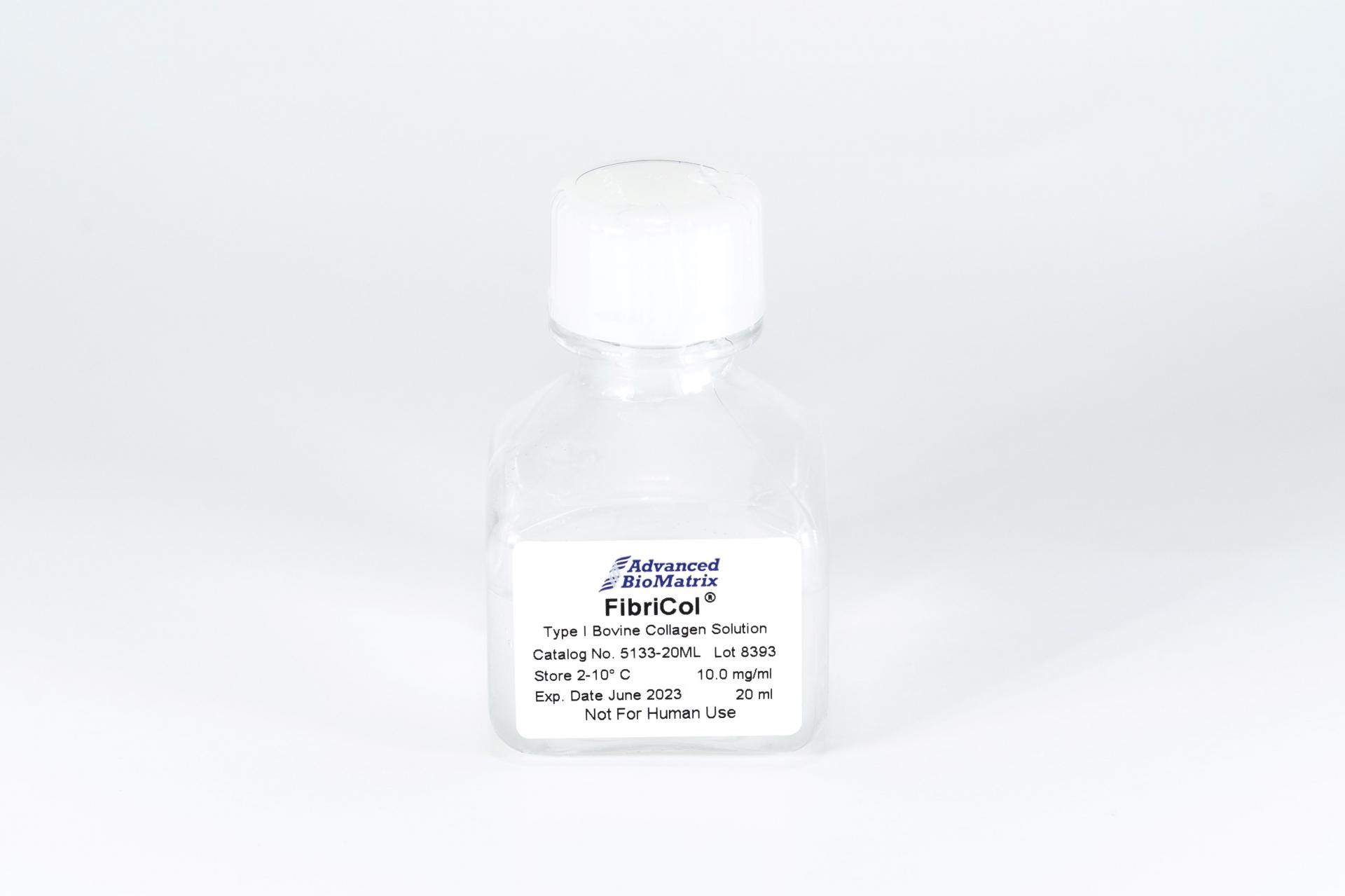-
Collagen
-
Type I - Atelocollagen
- PureCol® Solution, 3 mg/ml (bovine) #5005
- Nutragen® Solution, 6 mg/ml (bovine) #5010
- FibriCol® Solution, 10 mg/ml (bovine) #5133
- PureCol® EZ Gel, Solution, 5 mg/ml (bovine) #5074
- PureCol® Lyophilized, 15 mg (bovine) #5006
- VitroCol® Solution, 3 mg/ml (human) #5007
- VitroCol® Lyophilized, 15 mg (human) #5008
-
Type I - Telocollagen
- TeloCol®-3 Solution, 3 mg/ml (bovine) #5026
- TeloCol®-6 Solution, 6 mg/ml (bovine) #5225
- TeloCol®-10 Solution, 10 mg/ml (bovine) #5226
- RatCol™ for 2D and 3D, Solution, 4 mg/ml (rat) #5153
- RatCol™ High Concentration, Solution, 10 mg/ml (rat)
- RatCol™ lyophilized, 100 mg (rat)
- RatCol™ for Coatings, Solution, 4 mg/ml (rat) #5056
- Type I - Insoluble Collagen
- Type I - Bioinks
- Type II Collagen
- Type III Collagen
- Type IV Collagen
- Collagen Standard
-
PureCol® Collagen Coated Plates
- Collagen Coated T-25 Flasks #5029
- Collagen Coated 6-well Plates #5073
- Collagen Coated 12-well Plates #5439
- Collagen Coated 24-well Plates #5440
- Collagen Coated 48-well Plates #5181
- Collagen Coated 96-well Plates #5072
- Collagen Coated 384-well Plates #5380-5EA
- Collagen Coated 100 x 20 mm Dishes #5028
- MatTek Glass-Bottom Dishes
- MatTek Multi-Well Plates
- Collagen Scaffolds
- Collagen Hybridizing Peptides
-
Type I - Atelocollagen
- Tunable Stiffness
- CytoSoft™ Rigidity Plates
-
Bioprinting
- Support Slurry for FRESH Bioprinting
-
Bioinks for Extrusion Bioprinting
- Lifeink® 200 Collagen Bioink (35 mg/ml) #5278
- Lifeink® 220 Collagen Bioink (70 mg/ml) #5343
- Lifeink® 240 Acidic Collagen Bioink (35 mg/ml) #5267
- Lifeink® 260 Acidic Collagen Bioink (70 mg/ml) #5358
- GelMA Bioink
- GelMA A Bioink
- GelMA C Bioink
- Pluronic F-127 40% Sterile Solution
- GelMA 20% Sterile Solution
- Alginate 5% Sterile Solution
- Photoinitiators
- Bioinks for BIONOVA X
- Bioinks for Lumen X
- DLP Printing Consumables
-
Create Your Own Bioinks
- PhotoCol® Methacrylated Collagen
- PhotoGel® Methacrylated Gelatin 95% DS
- PhotoGel® Methacrylated Gelatin 50% DS
- PhotoHA®-Stiff Methacrylated Hyaluronic Acid
- PhotoHA®-Soft Methacrylated Hyaluronic Acid
- PhotoAlginate® Methacrylated Alginate
- PhotoDextran® Methacrylated Dextran
- PEGDA (Various Molecular Weights)
- Silk Fibroin, Solution
- PhotoSericin® Methacrylated Sericin
- Bioprinters
-
3D Hydrogels
- Thermoreversible Hydrogel
- Silk Fibroin
-
Type I Collagen for 3D Hydrogels
- PureCol® Solution, 3 mg/ml (bovine) #5005
- Nutragen® Solution, 6 mg/ml (bovine) #5010
- FibriCol® Solution, 10 mg/ml (bovine) #5133
- PureCol® EZ Gel, Solution, 5 mg/ml (bovine) #5074
- VitroCol® Solution, 3 mg/ml (human) #5007
- TeloCol®-3 Solution, 3 mg/ml (bovine) #5026
- TeloCol®-6 Solution, 6 mg/ml (bovine) #5225
- TeloCol®-10 Solution, 10 mg/ml (bovine) #5226
- RatCol® for 3D gels, Solution, 4 mg/ml (rat) #5153
- HyStem® Thiolated Hyaluronic Acid
- Methacrylated Collagen
- Methacrylated Gelatin
- Methacrylated Hyaluronic Acid
- Diacrylates
- Collagen Sponges
- Methacrylated Polysaccharides
- Spheroids and Organoids
- Extracellular Matrices
- HyStem / Hyaluronic Acid
-
Adhesion Peptides / Proteins
-
Recombinant Adhesion Proteins
- CD2, 0.5 mg/ml #5086
- CDH3, 0.5 mg/ml #5124
- CDH13, 0.5 mg/ml #5125
- CD14, 0.5 mg/ml #5089
- CDH18, 0.5 mg/ml #5090
- CD40, 0.5 mg/ml #5093
- CD86, 0.5 mg/ml #5096
- CD164, 0.5 mg/ml #5100
- CD270, 0.5 mg/ml #5127
- CD274, 0.5 mg/ml #5126
- CD276, 0.5 mg/ml #5123
- E-Cadherin (CD324), 0.5 mg/ml #5085
- ICAM2, 0.5 mg/ml #5107
- Adhesion Peptides
- Collagen Hybridizing Peptides
-
Recombinant Adhesion Proteins
- Reagents
- Assays
Collagenase
Powder
Catalog #5030
Collagenase
Powder
Catalog #5030
This Collagenase product is provided as a lyophilized, sterile powder in a 50 mg package size. It has been tested specifically and shown to effectively hydrolyze collagen and dissociate tissues.
Product Description
Collagenase consists of a blend of enzymes including collagenase, caseinase, clostripain and trypsin designed to effectively hydrolyze collagen and dissociate tissues. Various collagenase products have been evaluated specifically for use with Advanced BioMatrix’ s collagen products. This product is offered to improve the viability and functionality of isolated cells from the digested collagen gels.
Collagenase is provided as a lyophilized, sterile powder in a 50 mg package size. After reconstitution, the product is ready-to-use.
| Parameter, Testing, and Method | Collagenase #5030 |
| Form | Lyophilized Powder |
| Package Size | 50 mg |
| Storage Temperature | 2-10°C |
| Sterilization Method | Filtration |
| Bioburden (cfu) | <1 |
| Source | Clostridium Histolyticum |
| Shelf Life | Minimum of 6 months from date of receipt |
Directions for Use
Download the Directions for Use PDF or continue reading below:
- Use these recommendations as guidelines to determine the optimal gel dissociation procedure for your culture system.
- Reconstitute the lyophilized collagenase powder (50 mg) in phosphate buffered saline or other pH neutral medium. A typical concentration of 1 mg/ml may be used.
- Aspirate the culture medium from the collagen gel.
- Wash the collagen gel 2X with pre-warmed PBS or other pH neutral medium to remove culture medium which could inhibit the degradation of collagen.
- Add appropriate amount of collagenase solution (one gel volume should be sufficient). For example: For 24 well plates, containing 0.5 ml of gel, add 0.5 ml of collagenase solution.
- Transfer to a 37ºC incubator for 30-60 minutes. To facilitate the faster dissociation of the collagen gel, the gel and collagenase solution can be pipetted up and down using a large bore pipette tip.
- Incubate additional 30-60 minutes at 37°C, if necessary, to complete the digestion of the gel. If required, pipette the gel/cell mixture every 15 minutes. Note: Thicker gels or gels containing higher concentration of cells may require more time.
- Once the gel is fully digested, add an equal volume of complete culture medium to the gel/cell mixture and then collect the cells.
- Rinse the culture vessel collecting any residual cells.
- Centrifuge the cell suspension at 250 x g for 5 minutes at room temperature.
- Carefully aspirate the supernatant, and resuspend the cell pellet in 0.5 -1 ml of fresh medium.
- Determine cell count and viability using a hemocytometer and Trypan Blue.
Product Q & A
Yes.
There are sufficient levels of divalent cations in the lyophilized collagenase powder to achieve full enzymatic activity. Therefore, solubilizing the lyophilized collagen powder in medium or a phosphate buffered solution without divalent cations is recommended per the Directions for Use.
Collagenase is most stable in the lyophilized form stored at 2 to 10°C. After reconstitution, it is recommended that any remaining solubilized collagenase be aliquoted into desired volumes and then frozen at < -20°C for up to 1 to 2 months. Repeat freezing and thawing is not recommended.
https://www.ncbi.nlm.nih.gov/pmc/articles/PMC4698262/
Product References
Collagenase References:
Röck, Katharina, et al. "Collagen fragments inhibit hyaluronan synthesis in skin fibroblasts in response to ultraviolet B (UVB) new insights into mechanisms of matrix remodeling." Journal of Biological Chemistry 286.20 (2011): 18268-18276.
Shieh, Hester F., et al. "Comparisons of human amniotic mesenchymal stem cell viability in FDA-approved collagen-based scaffolds: Implications for engineered diaphragmatic replacement." Journal of pediatric surgery 52.6 (2017): 1010-1013.
Kumar, Balasubramanian K., et al. "The effects of over expressing aquaporins on the cryopreservation of hepatocytes." Cryobiology 71.2 (2015): 273-278.
Yang, Xi, and William F. Salminen. "Kava extract, an herbal alternative for anxiety relief, potentiates acetaminophen-induced cytotoxicity in rat hepatic cells." Phytomedicine 18.7 (2011): 592-600.
Ingeson-Carlsson, Camilla, Angela Martinez-Monleon, and Mikael Nilsson. "Differential effects of MAPK pathway inhibitors on migration and invasiveness of BRAFV600E mutant thyroid cancer cells in 2D and 3D culture." Experimental cell research 338.2 (2015): 127-135.
Voedisch, Sabrina, et al. "Neuropeptides control the dynamic behavior of airway mucosal dendritic cells." PloS one 7.9 (2012): e45951.
Product Certificate of Analysis
No result for .
Product Disclaimer
This product is for R&D use only and is not intended for human or other uses. Please consult the Material Safety Data Sheet for information regarding hazards and safe handling practices.







